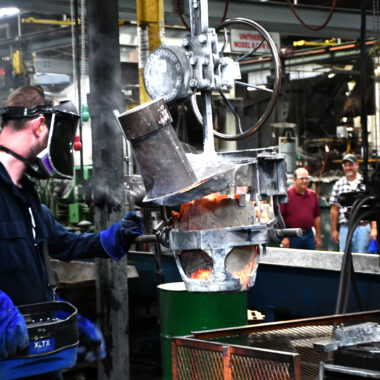Aluminum Casting Proficiency: Approaches to Raise Your Production Process
Wiki Article
Dive Into the Globe of Light Weight Aluminum Casting: Comprehending the Different Methods
Aluminum casting is a basic process in the manufacturing sector, with various approaches employed to produce precise and complex components. From the conventional sand spreading method to the sophisticated die spreading process, each technique supplies unique advantages depending on the requirements of the project.Sand Spreading Approach
Sand casting, a widely-used method in light weight aluminum spreading procedures, involves producing mold and mildews made of compressed sand for putting molten metal. This technique is very functional and affordable, making it a prominent selection for different industries. The process begins with the creation of a pattern, typically made of wood or metal, which is then pressed into the sand to leave an impact. The sand mixture, generally silica sand combined with a binder like clay, is firmly packed around the pattern to create a mold and mildew cavity. Once the mold and mildew is all set, it is firmly positioned in a flask and molten aluminum is put right into the dental caries.After the metal has cooled and solidified, the sand mold is escaped to disclose the light weight aluminum casting. Sand casting enables the manufacturing of intricate shapes and large components that might be tough or costly to produce making use of various other techniques. It is also a lasting strategy as the sand can be recycled and used numerous times, lowering waste in the spreading process.
Irreversible Mold Strategy

One considerable advantage of the Irreversible Mold And Mildew Strategy is the improved dimensional precision it uses. The metal mold allows for tighter tolerances and better information in the last light weight aluminum spreadings compared to sand spreading methods. This accuracy makes it a recommended selection for applications where limited dimensional control is vital, such as in the automotive and aerospace sectors.

Pass Away Casting Refine

Financial Investment Casting Method
Making use of an accuracy spreading technique, Investment Casting Technique involves creating intricate aluminum elements by pouring molten steel into a ceramic mold. This process, likewise referred to as lost-wax casting, starts with the development of a wax pattern of the preferred part. This wax pattern is after that coated with a ceramic material to create a shell. Once the ceramic covering is solidified, it is warmed to get rid of the wax, leaving a hollow ceramic mold and mildew.Financial investment spreading is typically utilized for manufacturing elements in sectors where limited tolerances and elaborate styles are called for, such as aerospace, automotive, and medical devices. The flexibility and accuracy of the Financial investment Casting Approach make go to my blog it an important method in the world of light weight aluminum casting.
Lost Foam Casting Technique
Having actually discovered the detailed accuracy of Financial investment Casting Technique, the emphasis currently changes to the cutting-edge approach of Lost Foam Spreading in aluminum part production. Lost Foam Casting, also referred to as evaporative pattern casting, is a modern strategy where a foam pattern of the desired part is created and after that covered with a refractory product. The coated foam pattern is then buried in sand, and molten aluminum is poured right into the mold and mildew. As the steel fills the mold, the foam vaporizes as a result of the warmth, leaving a tidy tooth cavity in the shape of the wanted component.Additionally, Lost Foam Casting is a cost-efficient process as it lowers the requirement for cores and permits for the production of light-weight parts. Despite its benefits, Lost Foam Spreading needs mindful control of the casting process to protect against flaws and guarantee top quality components.
Final Thought
Finally, light weight aluminum casting provides a selection of approaches such as sand casting, long-term mold strategy, pass away spreading, investment casting, and lost foam casting. Each technique has its own benefits and applications, making light weight aluminum casting a versatile and commonly utilized procedure in numerous sectors. Comprehending the distinctions in between these approaches is essential in choosing one of the most ideal casting technique for particular production demands.Sand spreading, a widely-used approach in light weight aluminum spreading procedures, entails developing mold and mildews made of compacted sand for putting molten steel. aluminum casting.The Permanent Mold Technique, like sand casting, is another common approach used in light weight aluminum spreading processes, using unique advantages in terms of mold and mildew reusability and dimensional precision. The metal mold allows for tighter resistances and better information in the final aluminum spreadings contrasted to sand spreading techniques. The two primary kinds of die spreading are chilly chamber die casting and hot chamber pass away casting, each appropriate for different types of light weight aluminum alloys.In verdict, light weight aluminum casting uses a selection of techniques such as sand casting, permanent mold and mildew strategy, die casting, financial investment spreading, and shed foam casting
Report this wiki page